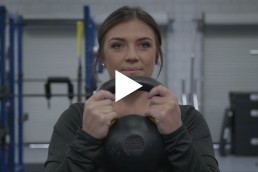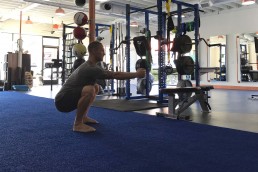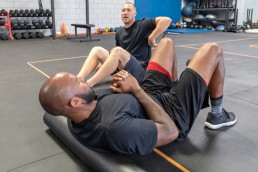What if pitching more isn’t the answer to getting better? I know that sounds absurd right? Everyone knows practice makes us better…. but does it?
What if a pitcher starts throwing from a very early age (maybe 7, 8, 9 even 10 or 11); ages that means they are still developing their basic strength? In all reality they haven’t developed adequate strength in the areas they would need to deliver a pitch with efficient mechanics. Lets say for the example they don’t have enough glute strength to effectively push (foot into ground) and explode (hip extension) off the rubber. How many times does a coach or parent tell a pitcher to drive hard off the rubber? If they don’t have enough glute strength to push off they are likely to find another method to achieve the task. The brain will take the path of least resistance to get the task done. Maybe that path of least resistance is using momentum from an aggressive back swing of their arm, or a wild glove arm flying away from the body as they began their arm circle,
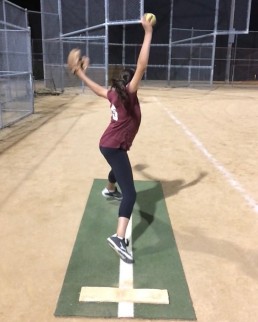
or maybe, a glove leg extending and reaching out to pull the body forward.
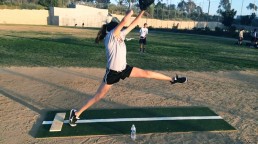
Suppose that young athlete does a “good” job of using that alternate method and in the short run it gives them some success. They deliver the ball with some decent velocity and manage to locate their pitches. That pitcher follows the instruction of more practice and does so by throwing 50+ pitches a day, 3-4 days a week, 11 months out of the year. As she keeps practicing her pitching she continues to “cement” that alternative movement pattern as a normalized body movement in their motion. Now what is crazy about the body is that when the brain no longer needs to use a particular muscle it will “forgot” how to activate that muscle and effectively “shut it off”. The muscle is not dead, but the signal to the muscle is switched off, because the brain sees it as unimportant and not needed.
So fast forward to when that same pitcher is now 17, or 18 and wants to increase velocity. She has been stuck at say 58 mph for a few years and is really eager to get over that 60 MPH velocity hurdle. Not to mention college coaches have expressed interest if the velocity increases. The pitcher and her parents go out in search of a coach who can increase her velocity. Sure, the pitching coach can point out the faults in the mechanics that might be causing the loss in velocity (although sadly that is not always the case), but can those mechanical issues really be fixed by pitching more? You might see some pitching coaches using softball specific drills to help the athlete feel the desired change, and sometimes that might work at a slow controlled speed, but once that pitcher returns to the rubber to deliver a full game speed pitch the fault in mechanics comes right back. An external stimulus needs to be introduced to the brain and body to elicit an adaptation to change in the current pattern the brain has “memorized”. That adaptation can be in muscle strength, speed strength, neuromuscular efficiency (better signal going to muscle from brain), or more muscle fiber recruitment. That means maybe resistance training to gain strength where needed or placing an athlete in a specific position to make the brain remember how to activate a particular muscle. Simply doing the same motion that has been practiced for hundreds of thousands of reps is not enough to elicit any significant changes in strength. Take the athlete into a weight room, or training room, and address the weakness in a strength or rehab program (if pain is also present) and allow the body’s to adaptation create the desired change in their mechanics. Once the adaptation has occurred the new or improved movement pattern can be incorporated into the pitching mechanics.
Here is what you can do to help your daughter or pitchers on your team:
- If you are in the San Diego, or Southern California Area, send us an email at info@symtraining,com and we can get you set up on an assessment to help identify your potential issues.
- If you don’t live in the area, research some strength coaches in your area, or find a Physical Therapist or Chiropractor who will run your through a movement screen, and follow their recommendation for where to go from there.
- Look back at video or pictures from past seasons and see if the mechanic issue you have now were present in past seasons (if so pitching more hasn’t solved the problem).
- Don’t jump into a training program until you have been assessed or evaluated first. You need to know where to start before you start.
- Look at the previous 12 months, if you haven’t taken a break from throwing (at least 2 + consecutive weeks) than you are certainly throwing more than your body can handle.
Dana Sorensen
Co-Founder of Symbiotic Training Center
Dana is a uniquely different softball pitching instructor with combined experience as a player, coach and sports performance specialist. She began her journey as an athlete competing for Stanford University, the National Pro Fastpitch League, and Team USA. She is a 3 time All-American, 4 Time All Pac-10 team, and was recently inducted into the Stanford Athletics Hall of Fame.
The Importance Of In-Season Strength Training For Pitchers
In the softball community, there seems to be some confusion about both the value of strength training and the value of strength training in season. For me, it’s very clear: DO BOTH.
Creating a Daily Routine
Since training in season and keeping your body feeling healthy can be so difficult, it’s important to have a daily routine. Something that will keep your body moving and feeling better, but also act as a daily self assessment.
Microdosing
Microdosing is the practice of performing small amounts of training in order to physiologically benefit, while minimizing undesirable side effects.


